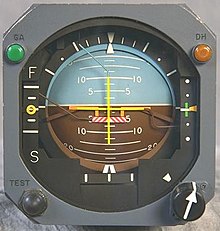Navigational instrument
As navigation instruments mainly those are instruments referred to for determining the spatial position of serve and the movement of aircraft and other missiles. They are an essential aid in flight navigation .
In the traditional cockpit of an aircraft, they are usually arranged in duplicate - in front of each of the two pilot seats - in order to be in the direct field of vision of the pilot for position control . In newer, computerized cockpits, on the other hand, the measurement result from several instruments is combined into a common display.
The navigation instruments mainly include:
- Artificial horizon and (mostly) turn indicator
- Compass systems (magnetic and radio compass)
- Gyro (Engl. Gyro )
- Airspeed indicator and outdoor thermometer
- two altimeters (coarse and fine), radar altimeter
- Clocks
- VOR and other radio navigation systems.
The navigation instruments, together with the flight monitoring devices, have the task of detecting the position and movement (sometimes also the position) of an aircraft and displaying them to the pilots in a form that can be quickly grasped.
In contrast to the navigation instruments, the devices for airframe engine monitoring are arranged in the center console of the cockpit, so only a single version is available. They include u. a. Engine and oil pressure control, synchroscopes and the display of all adjustable aircraft parts such as landing flaps , flaps, landing gear and trim.
Navigational instruments are colloquially - outside of flight navigation - but also instruments for other methods of navigation and location determination , for example
- GPS receiver (GPS navigator)
- Devices for bearing and direction measurement (e.g. sextant), NMEA display devices , etc.
- Receiver for radio navigation (e.g. VOR / DME or Decca, Consol , the former Omega)
- Mobile GPS navigation systems
- Complex groups of instruments ( integrated navigation ) - such as the combination of GPS receivers and inertial navigation systems .
